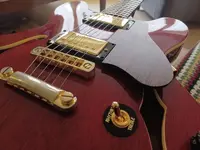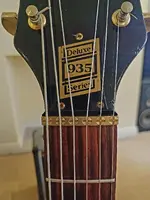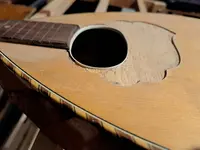The main stumbling block has been...the pickguard.
I have no trade secrets. If I did, I would be rich

It certainly looks like an interesting project.
If someone brought that to me, and I'm no luthier by any stretch, I would do the following:
1. I would make a cardboard template of the pickguard. It looks to me that the edges are fairly intact, and smooth, which is a good thing. I wouldn't worry TOO much about getting it perfect. Making the template a little "proud" might be a good idea. I would certainly pay close attention to the sound hole dimensions. That would be a key dimension.
2. I would carefully fill the "hole" with a good wood filler. A small layer at a time and build it up to the surface of the soundboard. I think a little shy of the soundboard would be OK because as you sand it, you don't want to scratch the top.
3. Alternatively, you could use an epoxy filler, but that won't "give" as much with temperature changes, Living in Maine, that may not be a good choice for you.
4. If you're handy with a small band saw you would take the template and cut a piece of plastic to fit. You might be able to find a pickguard for a Tele or a Strat. or buy a blank of the same thickness. I would certainly be aware that you don't want it so high that it interferes with the strings.
5. OR, you could follow step 4 and disregard filling the hole. Keeping in mind that either option will have an effect on the tone.
If it has sentimental value to you, try and repair it. If it doesn't work out, c'est la vie. I wouldn't turn it into a bird house until you try it. It's a beautiful instrument; you have $$ invested in parts; and it seems you're interested in a good project.








